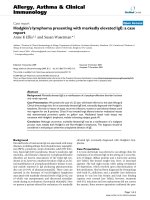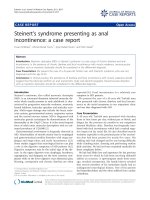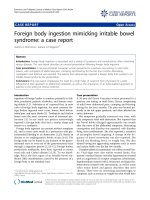Báo cáo y học: " Hodgkin’s lymphoma presenting with heart failure: a case report" pot
Bạn đang xem bản rút gọn của tài liệu. Xem và tải ngay bản đầy đủ của tài liệu tại đây (218.7 KB, 3 trang )
CAS E RE P O R T Open Access
Hodgkin’s lymphoma presenting with heart
failure: a case report
Zeinab Amirimoghaddam
1
, Malihe Khoddami
1
, Nahid Dehghan Nayeri
2*
, Somayeh Molaee
2
Abstract
Introduction: Cardiac involvement in malignant lymphoma is one of the least investigated subjects in oncology.
This article reports a case of cardiac involvement in Hodgkin’s lymphoma which presented as heart failure.
Case presentation: We report the case of an 8-year-old Afghan girl with Hodgkin’s lymphoma. The disease
presented with systemic signs and symptoms, inclu ding abdominal distension, weakness, pallor, chills, fever,
generalized edema, hepatosplenomegaly and generalized lymphadenopathy, as well as signs of heart failure. Test
results showed a rare form of heart metastasis.
Conclusion: We report a case of Hodgkin’s lymphoma with metastasis to the heart, detected premortem.
Although the involvement of the heart in a malignancy is relatively common, premortem detection is unusual and
only few studies have reported it in the literature.
Introduction
Cardiac involvement in malignant lymphoma is one of
the least investigated subjects in oncology [1]. Cardiac
metastases are found in 20% to 25% of patients with
lymphoma [2,3]. Studies by R oberts et al.andCainset
al. reported that 9% of all cardiac tumors are related to
lymphoma [3,4]. Some authors have described primary
cardiac ly mphomas presenting with pericardial effusion
[5], arrhythmias and heart failure [6]. Echocardiography
is known to be a sensitive method for the diagnosis of
cardiac involvement in patients with lymphoma. The
pattern of cardiac involvement varies with different
types of lymphoma, suggesting that different pathologic
types of lymphoma m ay have different mechanisms of
metastasis to the heart. Diffused myocardial infiltration
documented by echocardiography has rarely been
described as a prese nting feature of this condition [7,8],
but it is commonly found postmortem [9].
Bashir et al. explained the pathogenesis of cardiac
involvement in lymphoma in their 2006 study [10]. One
sixth of neoplastic pericardial disease s are caused by
hematological malignancies. However, the incidence,
clinical course and outcome of pericardial involvement
in Hodgkin’ s lymphoma are unknown. Lymphomas
involve the pericardium mostly via lymphatic or hema-
togenous metastasis. This type of pericardial involve-
ment generally results in pericar dial effusion as a
consequence of the obstruction of the venous and lym-
phatic flows of pericardial fluid. Although most cases
are clinically silent, effusions can impair cardiac func-
tion. In severe cases it can even lead to pericardial tam-
ponade, which is a life-threatening condition.
The d iagnostic standard in these conditions includes
acquiring the patient’s history and performing physical
examinations, chest radiography, contrast-enhanced
computed tomography (CT) of the neck, chest, abdo-
men, and pelvis, and gallium scan or positron emission
tomography. Patients with suspected bone involvement
usuallyundergobonescans,whilepatientsinthe
advanced stages of the disease undergo bone marrow
biopsies. Baseline studies consist of a complete blood
count, blood chemistry ana lyses, kidney and liver func-
tion tests, echocardiography, electrocardiography, and
pulmonary function tests [10].
Low-dose radiation plus multi-agent chemotherapy for
pediatric Hodgkin’s disease was adopted after a pioneer-
ing study reported using 15 to 25 Gy and six cycles of
mechlorethamine, vincristine, procarbazine, and predni-
sone chemotherapy for children [11]. Chemotherapy
standards in Hodgkin’s are VEPA (vinblastin, etoposid e,
prednisolone, adriamycin), VAMP (vinblastin,
* Correspondence:
2
Faculty of Nursing and Midwifery, Tehran University of Medical Sciences,
Nosrat St, Tohid Square, Tehran, 1419733171, Iran
Amirimoghaddam et al. Journal of Medical Case Reports 2010, 4:14
/>JOURNAL OF MEDICAL
CASE REPORTS
© 2010 Amirimoghaddam et al; licensee BioMed Central Ltd. This i s an Open Access article distributed under the terms of the Creative
Commons Attr ibution License (http ://creativecommons.org/licenses/b y/2.0), which permits unrestricted use , distribution, and
reproduction in any medium, provided the original work is properly cited.
Adriamycin, methotrexate, prednisone) , COP (c yclopho-
sphamide, vincristine, procarbazine) and Stanford V
(doxorubicin, vinblastin, mechlorethamine, vincristine,
bleomycin, etoposide, prednisone).
Primary presentations of Hodgki n’s lymphoma have
been reported many times, but heart failure in Hodg-
kin’s lymphoma has not yet been reported in the litera-
ture. This case report describes a rare case of cardiac
involvement in Hodgkin’s lymphoma which presented as
heart fail ure and was diagnosed through echocardiogra-
phy findings.
Case presentation
An 8- year-old Afghan girl presented with a two-month
history of edema, abdominal distension, weakness, pal-
lor, chills, fever, anorexia, and weight loss. Her medical
history was not remarkable. Physical examinations
showed severe mucosal and conjunctival pallor, periorbi-
tal and sacral edemas, and abdominal distension. She
also presented with tender mobile lymph no des in her
right neck (5 × 5 mm), bilateral inguinal area (0.5 cm ×
0.5 cm) and left a xillary (0.7 cm × 0.7 cm), as well as
marked hepatosplenomegaly and ascites with shifting
dullness. Systolic murmurs (II/III) of the heart and
lungs were apparent.
In th is patient, Hodgkin’s lymphoma had metastasized
to the myocardial tissue. The tumor involved all the car-
diac tissue and the septum. Metastasis must have
occurred via the blood vessels because it involved the
cardiac tissue itself as well as the lymph nodes. Other
hematopoetic areas such as the liver, spleen and bone
marrow were also involved.
The symptoms of lymphadenopathy included enlarge-
ment of the l ymph nodes, in particular the para-aortic
lymph nodes. There were symptoms of cardiac failure in
the form of tachycardia, cardiomegaly, gallop rhythm,
tachypnea, weak pulse, and hypotension.
In examining the patient, we used all diagnostic stan-
dards except positron emission tomography, because the
patient had already been diagnosed with lymphoma and
metastasis. There wer e no signs of Hodgkin’s lymphoma
in the bone marrow and bone aspiration test results.
Laboratory findings included severe anemia with mod-
erate anisopoikilocytosis, hemoglobin level of 3.2 (nor-
mal range 260 to 400 mg/dl), erythrocyte sedimentation
rate of 50 (normal r ange <15 mm/hr), and positive C-
rea ctive protein. Polymerase chain reaction for tubercu-
losis, blood culture, urine culture, hydatid antibody,
Coombs Wright and 2 ME, direct Coombs, bone mar-
row c ulture, and blood smears for malaria and borrelia
were all negative. Our patient’ sG6PDlevelwasalso
normal.
There were several findings that led to the identifica-
tion of appropriate treatment for our patient. In
abdominal sonography, her liver was found to be
enlarged with heterogenic echo. Marked hepatospleno-
megaly (spans = 17 cm) and two round hypoechoic
areas in the hepatic portal space due to adenopathy
were seen. Her biliary gall bladder had no stones and its
wall had an increased thickness. An abdominal CT scan
(with and without contrast) showed severe hepatosple-
nomegaly, a hypodense area in the liver that might be a
small hemangioma or cyst, considerable para-aortic ade-
nopathy, and dilated small bowel loops with thickened
walls. Her spleen was enlarged to a diameter of 13 cm
and had homogenous echo. Her internal and external
biliary tract liver were of normal d iameter. There were
some circular hypoe choic masses in our patient’s porto-
hepatic region, which indicated lymphadenopathy in this
area. Her para-aortic region could not been observed
bec ause of the abdominal gas. Her intest inal loops were
dilated in the pelvic region and were full of liquid.
Her kidneys had normal secretions and ap peared nor-
mal. No other abnormalities were seen. Her lungs were
clear and of normal size, as shown on contras t chest X-
ray. The chest X-ray also showed cardiomegaly. A CT
scan of our patient’s chest showed multiple lymph ade-
nopathies in the paratracheal and subcarinal regions.
Our patient’s lung parenchymas were reported to be
normal in a thorax CT scan with contrast. There were
no effects of impressed masses, paren chymal nodules or
abnormal infiltration. The vessels and bronchus seemed
normal. Multiple l ymph nodes were seen in the para-
aorta, subcarina, lungs or esophagus.
Anemia due to tumor involved all parts of the hema-
topoetic areas such as the liver, bone marrow and
spleen, and also due to cardiac deficiency and endocar-
ditis. Cardiac failure could occur after a bacterial endo-
carditis and the tumor development. There was also
lymphadenopathy, pericardial effusion, fever, t remor,
and edema.
In treating our patient, acute symptoms such as severe
anemia, infection, electrolyte and biomedical imbalances
and hypoglycemia were encountered. Once these had
been treated, we addressed the Hodgkin’s lymphoma.
Our patien t was given a high-prot ein and high-calorie
diet, and treatment for tuberculosis was started. Genta-
mycin, penicillin , and vancomycin were prescrib ed
because of the presenting endocarditis. After stabling
the patient’ s condition, 14 sessions of chemotherapy
were started. Chemotherapy included intravenous Adria-
mycin (doxorubicin) 25 mg/m
2
, Bleomycin 10 mg/m
2
,
and vincristine 6 mg/m
2
, as well as 375 mg of dimethyl,
triazeno, imidazole and carboxamide (DTIC) as infusion.
After one year, no e vidence of the disease were
reported in a thorax CT scan with injection contrast or
in abdominal and pelvic CT scans with oral and injec-
tion contrast. There was also no evidence of abnormal
Amirimoghaddam et al. Journal of Medical Case Reports 2010, 4:14
/>Page 2 of 3
opacity in the lung parenchyma. The pathologic area
was not seen either in the t horax bone structure or the
adjacent soft tissue. There were no symptoms of either
pleural fluid or pleural thickness. There was also no evi-
dence of the anterior, medial o f posterior mediastinal
masses. The major vessels appeared normal. Small aor-
tocaval and thorocaval lymph nodes were observed. A
myeloma with a maximum diameter of 1 cm at the left
kidney was detected. The size and density of our
patient’s kidneys were normal. The urine tract was not
obstructed. The hilar areas were normal in both kidneys.
The bronchus had normal calibers. The gall bladder and
the internal and external liver biliary tracts were also
normal. The spleen was of normal size and had systema-
tic margins and homogenous density. The attenuation
valve was also normal.
After completing the treatment, our patient was dis-
charged. Her parents were told that she should attend
our clinic for follow up every three months. A ll the
symptoms of the disease have now disappeared and t he
girl is living an ordinary life. She does not have symp-
toms of lymphadenopat hy, splenomegaly or any other
problems.
Conclusion
Although the involvement of the heart in malignancies
is relatively common, premortem detection is unusual
and only a few studies have reported this subject in the
literature. We report a case of Hodgkin’ slymphoma
which presented with systemic signs and symptoms
including abdom inal distension, weakness, pal lor, chills,
fever, generalized edema, hepatosplenomegaly and gen-
eralize d lymphadenopathy, as well as signs of heart fail-
ure. Echocardiography revealed pericardial effusion, left
ventricular hypertrophy, and lucent myocardial lesions.
A right cervical lymph node biopsy established the diag-
nosis of nodular sclerosing Hodgkin’ slymphomawith
involvement of the bone marrow at biopsy. After 14
chemotherapy sessions, systemic and cardiac abnormal-
ities had improved. To the best of our knowledge, this is
the first reported case of Hodgkin’s lymphoma accom-
panied by cardiac metastasis and heart failure.
Echocardiograph findings have shown that pericardial
effusion is the most common abnormality in cardiac
metastasis. The early detection of metastatic cardiac
involvement can be beneficial for the patients because it
can lead to careful monitoring, better management of
morbidity and decreased mortality.
Studies have shown that patients with lymphoma asso-
ciated with cardiac involvement can be treated
successfully.
Consent
Written informed consent was obtained from the
patient’s next-of-kin for publication of this case report
and any accompanying images. A copy of the written
consent is available for review by the Editor-in-Chief of
this journal.
Author details
1
Imam Hosein Hospital, Shahid Beheshti University of Medical Sciences,
Shahid Madani St, Nezamabad, Imam Hosein Sq, Tehran 1617763141, Iran.
2
Faculty of Nursing and Midwifery, Tehran University of Medical Sciences,
Nosrat St, Tohid Square, Tehran, 1419733171, Iran.
Authors’ contributions
ZA and MK gathered and interpreted data on the patient. NDN and SM
assisted in gathering and organizing the data. They were also major
contributors in writing the manuscript. All authors read and approved the
final manuscript.
Competing interests
The authors declare that they have no competing interests.
Received: 21 October 2008
Accepted: 20 January 2010 Published: 20 January 2010
References
1. Qingyi M, Hong L, Lima J, Wenjing T, Yuanyu Q, Shenghan L:
Echocardiographic and pathological characteristics of cardiac metastasis
in patients with lymphoma. Oncol Rep 2002, 9:85-88.
2. Roberts WC, Glancy DL, DeVita DT: Heart in malignant lymphoma: a study
of 196 cases. Am J Cardiol 1968, 22:85-107.
3. Cains P, Butany J, Fulop J, Ratowskin H, Hassaram S: Cardiac presentation
of non-Hodgkin’s lymphoma. Arch Pathol Lab Med 1987, 111:80-83.
4. Zuppiroli A, Cecchi F, Ciaccheri M, Dolara A, Bellesi G, Cecchin A, di Lollo S:
Two-dimensional echocardiographic findings in a case of massive
cardiac involvement by malignant lymphoma. Acta Cardiol 1985,
5:485-492.
5. Cabin HS, Costello RM, Vasudevan G, Maron BJ, Roberts WC: Cardiac
lymphoma mimicking hypertrophic cardiomyopathy. Am Heart J 1981,
102:466-468.
6. Roberts WC, Glancy DL, DeVita VT Jr: Heart in malignant lymphoma
(Hodgkin’s disease, lymphosarcoma, reticulum cell sarcoma and mycosis
fungoides): a study of 196 autopsy cases. Am J Cardiol 1968, 22:85-107.
7. Roberts WC: Primary and secondary neoplasms of the heart. Am J Cardiol
1997, 80:671-682.
8. Chandler S: Tumors of the heart. Arch Pathol Lab Med 1986, 110:371-374.
9. Klatt EC, Heitz DR: Cardiac metastasis. Cancer 1990, 65:1456-1459.
10. Bashir H, Hudson MM, Kaste SC, Howard SC, Krasin M, Metzger M:
Pericardial involvement at diagnosis in pediatric Hodgkin lymphoma
patients. Pediatr Blood Cancer 2006, 49:666-671.
11. Donaldson SS, Hudson MM, Lamborn Kr, Link MP, Kun L, Billett AL,
Marcus KC, Hurwitz CA, Young JA, Tarbell NJ, Weinstein HJ: VAMP and low-
dose, involved-field radiation for children and adolescents with
favorable, early-stage Hodgkin’s disease: results of a prospective clinical
trial. J Clin Oncol 2002, 20:3081-3087.
doi:10.1186/1752-1947-4-14
Cite this article as: Amirimoghaddam et al.: Hodgkin’s lymphoma
presenting with heart failure: a case report. Journal of Medical Case
Reports 2010 4:14.
Amirimoghaddam et al. Journal of Medical Case Reports 2010, 4:14
/>Page 3 of 3









